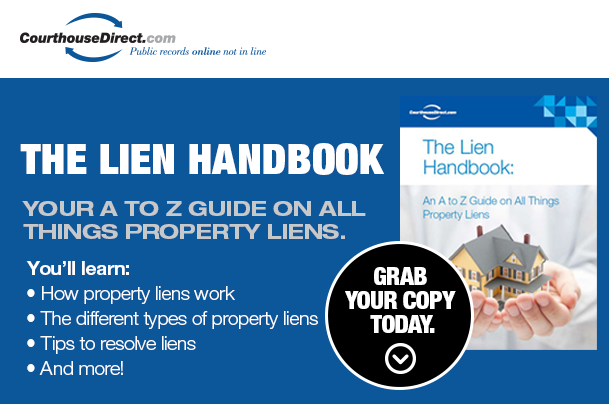 Whether you are a real estate investor or simply looking for a new home, an adverse lien can bring things to a screeching halt. One of the first steps of your due diligence is finding out if the property you are interested in purchasing has any clouds on its title or other obstacles to transfer of ownership.
Whether you are a real estate investor or simply looking for a new home, an adverse lien can bring things to a screeching halt. One of the first steps of your due diligence is finding out if the property you are interested in purchasing has any clouds on its title or other obstacles to transfer of ownership.
Luckily, you can perform most information searches, including those for liens, online. You don’t have to drive to the courthouse to look through their records, digital or print. There are a few things you should learn before going much further, though.
What Is a Lien?
A lien is a legal instrument or mechanism that gives a creditor a legal claim on your property asset to use as leverage for repayment of a debt.
Typically, the presence of a lien on real estate blocks the transfer of that property to a new owner, except under special circumstances. In any case, most real estate buyers prefer not to pursue what could be a protracted transaction.
If the debtor does not satisfy the obligation, a lien could result in the creditor seizing, repossessing, or foreclosing on the property. Also, a creditor could take legal action against a debtor to claim the first rights to any money brought by the asset's sale.
A lien is not the same as an encumbrance. An encumbrance is a different type of claim against a property by a party that is not the owner. Easements are a form of encumbrance. Money is not necessarily the issue, but encumbrances can affect the transferability of property and restrict its use.
Why Should You Care About Adverse Liens?
Besides the need for due diligence, so you know what you're getting into, you should care about adverse liens for a couple of other reasons.
One is that the lien could be a mistake. Somehow, a lien was recorded against a deed in error. It's also possible that the owner satisfied the obligation, but the lien was not removed.
It’s also possible for someone to place a lien fraudulently to obtain a mortgage or another loan that then becomes a lien against the property you wish to buy (or property you already own). In this case, ownership could be illegally transferred from you to the bad actors without your knowledge.
Types of Liens
This post is about adverse liens, but first, let's talk about consensual or voluntary liens. These are liens entered into with the full agreement of the debtor. The most common of these is a mortgage.
Most other types of liens are considered adverse and/or involuntary.
- Judgment liens result from a lawsuit brought by a creditor seeking payment for unsecured debt, such as credit card debt or a personal loan.
- IRS or tax liens result from a failure to pay taxes, either on income or property.
- Child support and alimony liens show the debtor owes substantial amounts of child support or alimony. A lien can be placed to compel payment.
- Mechanic’s and contractor’s liens are brought when the hiring party fails to pay for parts, services, or labor.
- Hospital liens grant hospitals and emergency services providers the right to claim payment for services out of any money recovered by a personal injury claim.
Judgment liens are often placed after a creditor wins a legal action and a monetary judgment. Mechanic's liens can be placed by subcontractors to get payment from a general contractor. However, the lien is against property not owned by the general contractor but by a customer.
Overview of Finding a Lien
The easiest way to find a lien is by using property ownership data. Once you have the name of the owner or the property address, it's a simple step to checking with the county clerk's office, searching online public records, or working with a title company to obtain a title report.
However, if you don't know the party's name, you may still find other documents that allude to a lien or judgment. You may find references in those documents relevant to a lien. You may find names or other data to cross-reference and find the information you need.
Terminology
One of the trickier aspects of locating an adverse lien, online or at the county courthouse, is learning the terminology, which is not standard from county to county.
For example, a federal tax lien may be designated as T/L, while state tax lien is designated STL. Abstracts of Judgment may be A/J. Another county may record these records in a totally different classification scheme.
Another difference in terminology involves grantor and grantee indexes.
- Real property/official records Grantee Index may be called a Reverse or Indirect Index for an involuntary lien.
- A grantor index may be called a direct index where all voluntary liens are listed.
Searching Online for Liens
Most modern public records are digitized. If you walk into the county courthouse today, you will probably be directed to a computer terminal to look up what you need. However, along with digitizing the records, many counties make them available for online search.
Companies, such as CourthouseDirect.com, aggregate records from all the counties within a state. Instead of traveling from courthouse to courthouse, you can find all the records you need at one time from your tablet, laptop, or PC.
You can search specifically for liens on CourthouseDirect.com by selecting the county, entering the party’s name, and a file date range. All adverse liens matching those criteria appear.
If needed, you can search using a partial name and a wildcard character. In all cases, correct spelling is crucial. Use as few letters as possible to bring up your listing if you’re unsure. Avoid typos when searching on any term.
One other method of finding adverse liens online is to search for lists of tax liens for sale.
Finding out about adverse liens against almost any property has never been easier. Once you understand the terminology and have a name and address, you can pull up an entire report on each property, including liens.
Once you know about the lien, you can decide if the property is worth pursuing. If so, you go in with the information you need to make the best decision.























